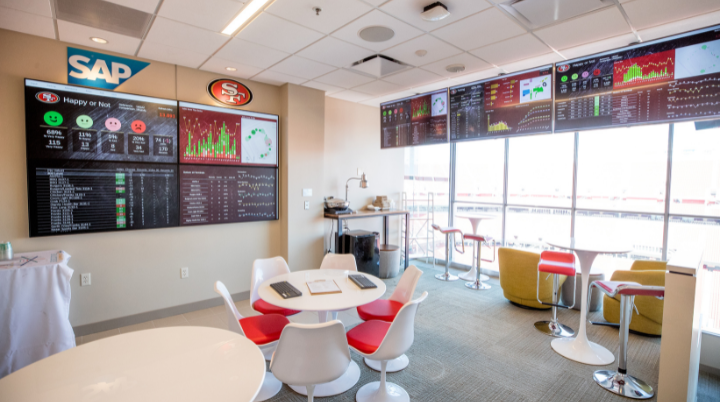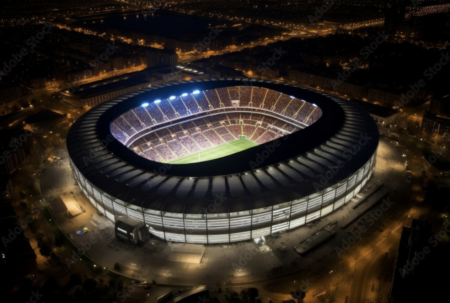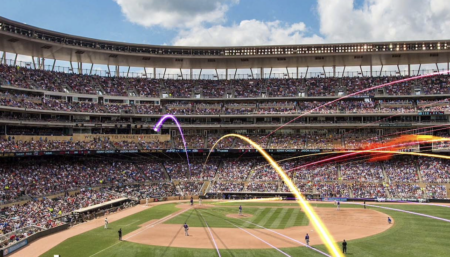Words by Benedict Evans.
Creating the perfect game-day experience for fans isn’t only about physical considerations such as seating and access – data and AI can now help managers to streamline operations, improving safety and efficiency.
There are myriad considerations which go into the upkeep of stadia, especially those venues hosting events that bring them to their designed capacity limit.
Once the turf or hardwood is ready, the concession stands are stocked, and the tickets are sold, safely admitting the public, and carefully managing their movement – and available resources – takes centre stage. Whether handling potential security threats, directing footfall to avoid incidences of overcrowding and injury, or attending to breakdowns in the infrastructure, these are difficult tasks requiring careful monitoring and lightning-quick response times.
As advanced as modern stadia may be, smarter use of data is not always at the forefront of management considerations. But here we profile two separate deployments of smart data-driven systems which are helping to improve safety and efficiency of venues.
One is the Executive Huddle, a management system used by the San Francisco 49ers and designed by SAP. The second is Smart Gateway, a perimeter screening solution from Xtract One Technologies.
In both cases data insight is proving to be the key to unlocking better venue management and an elevated fan experience.

The virtual quarterback
Levi’s Stadium is home to the San Francisco 49ers of the National Football League (NFL), a team with a rich sporting history and a loyal fan base. With an average NFL gameday attendance of 71,629 – the eighth largest in the league according to ESPN – there is an inherent crush risk which must be mitigated.
The 1.85 million square feet, open-design stadium has a seating capacity of 68,500, and this figure can stretch to nearly 80,000 if necessary.
The stadium was the first in the US to achieve LEED (Leadership in Energy and Environmental Design) gold certification in recognition of its green credentials. It was also the first to utilise SAP’s real-time analytics control room, which it calls the Executive Huddle (SAP is one of the world’s leading producers of software for the management of business processes).

“We needed to be able to interpret and visualise the information and make a decision in 15 seconds or less” Noele Crooks, director business intelligence and CRM, San Francisco 49ers
The Huddle works by condensing hundreds of data points into eminently readable charts. Often accessed by Noele Crooks, director of business intelligence and customer relationship management for the 49ers.
“Thanks to this collaboration with SAP that allows us to pull and display data in real-time, the stadium operations and business strategy teams are able to solve gameday fan experience issues within 10 minutes or less,” says Crooks.
Adjusting cadence
As director of business intelligence and customer relationship management, Crooks attends to four major pillars of the business: fan experience, business intelligence, corporate strategy, and branding.
Crooks was instrumental in the implementation of the Executive Huddle and says initial talks with SAP focused on speed of response as a key performance indicator. “We needed to be able to interpret and visualise the information and make a decision in 15 seconds or less,” says Crooks, adding, “We needed to ingest information and data which we didn’t own. Data from Ticketmaster, data from ParkCar, from point of sales etc.”
 This makes for one of the NFL’s most technologically advanced and environmentally friendly stadia. These are relatively recent changes however, which were met with resistance by boots-on-the-ground key stakeholders across retail, concessions, guest services, ticketing, parking, security, janitorial, emergency response, and medical.
This makes for one of the NFL’s most technologically advanced and environmentally friendly stadia. These are relatively recent changes however, which were met with resistance by boots-on-the-ground key stakeholders across retail, concessions, guest services, ticketing, parking, security, janitorial, emergency response, and medical.
“It’s taken time to develop,” says Crooks, “The first couple of games there might have been questions internally amongst stadium staff. Managers would ask, ‘Why are you calling me?’ It was because we knew what was going on.” But once stakeholders started seeing positive changes in response times and fan satisfaction metrics, attitudes shifted.

Crooks highlights the speed at which the stadium’s ingress and egress points can be predictively adapted to avoid overcrowding. “There’s a big difference between 1,000 people and 1,500 people. I don’t want to direct people to go from Gate F to Gate A. I want to let the security and ticketing managers know they’re about to get flooded, so they can move people over.” The flow of data and people is smooth, and the gameday experience is one to remember for all the right reasons.
Smarter security
Xtract One Technologies offers a weapons detection and perimeter screening solution called Smart Gateway. It follows similar analytic principles to that of the Executive Huddle. However, it takes these principles one step further, integrating artificial intelligence (AI) and machine learning.
The platform looks for five key characteristics exhibited by mundane everyday objects like phones, and less ordinary objects: knives, guns, and bombs. Then gives humans the ability to make more informed decisions. “Artificial intelligence is really good at taking millions of data points and parsing it down to three important ones. Humans are really good at taking three data points and making a judgement call,” says Peter Evans, CEO of Xtract One Technologies.

“AI is really good at taking millions of data points and parsing it down to three important ones. Humans are good at taking three data points and making a judgement call” Peter Evans, CEO, Xtract One Technologies
Everything is designed such that the decision-making is quick, and the security screening process unobjectionable. Like the Executive Huddle, the focus lies with data analysis. “We’re a heavy software company compared to others which are primarily hardware,” says Evans. “More and more venues are starting to use digital insights in order to streamline and optimise their operations.”

These insight demands have extensive applications for Xtract One Technologies’ client base, which spans automotive manufacturers like Kia and Hyundai, and extends to venue management titans like Oak View Group. “It allows us a lot of flexibility to adjust the system, to customise for each unique environment,” notes Evans. “We realised our platform had to be very flexible to fit into current security operations, as opposed to forcing security operations to be redesigned.”
Detection levels can be dynamically altered to account for attendee demographics, and data insights can and have been used to inform other business areas like marketing, advertising, and concessions. “Patron security and patron experience have always been in juxtaposition. AI and digital transformation are the glue that makes these things work together in harmony,” says Evans.

Future failsafe
Despite these already advanced systems, AI must be handled in such a way that biases are not made inherent within, or integral to, the system. “The patron experience starts the moment you or I decide we want to attend a game,” says Evans. “Then you’re online and I can gather information about you. Who are you? Who do you say you are? Are you using a false credit card?”
The limits placed on patron screening solutions must continually strike a balance between experience and safety, for these limits are entirely artificial. “We don’t know what the future holds, and how people are going to start using our AI,” says Evans. “But I think we’re only just scratching the surface.”
INSIDE THE EXECUTIVE HUDDLE
The Executive Huddle has been in use since 2018, with the 49ers’ most recent installation being six 3D-printed water and gas meter readers. The venue management solution tracks 10 unique data sources fed by 200 concession point-of-sales (POS) terminals, 250 parking and ticket scanners, and 100 fan satisfaction terminals. This latest utility tracking feature allows the 49ers to identify utility anomalies on game days, which it says promotes sustainable resource usage and allocation. “Sustainability has always been a cornerstone of Levi’s Stadium, dating back to the venue’s design process before we opened in 2014,” says Jim Mercurio, executive vice president and general manager of Levi’s Stadium. “Over the next decade, we will utilize the Executive Huddle’s new utility tracking feature to help inform new tactics and refine existing ones that help us reduce our environmental footprint.”
THE SMART GATEWAY
A 50-strong team has been developing the Smart Gateway since 2016, and CEO Peter Evans says it provide a fast, frictionless, and non-invasive alternative to the “standalone dumb devices” of yesteryear. Within each of the Smart Gateway’s towers are a set of sensors, informed by an AI platform trained on billions of data points and insights sourced from video cameras, gateways, and object analyses. The towers are plug-and-play; they can be battery or 120V powered, and operational within three minutes. Alerts can be sent locally to any browser-based device or integrated into a larger security operations centre (SOC). It also has integrated LCD tablets which can display a silhouette and picture of individual suspects.
This feature originally appeared in the 2023 March Issue of Stadia, which is available to read in its entirety here. If you would also like to receive physical copies of the magazine, please submit a subscription request.





